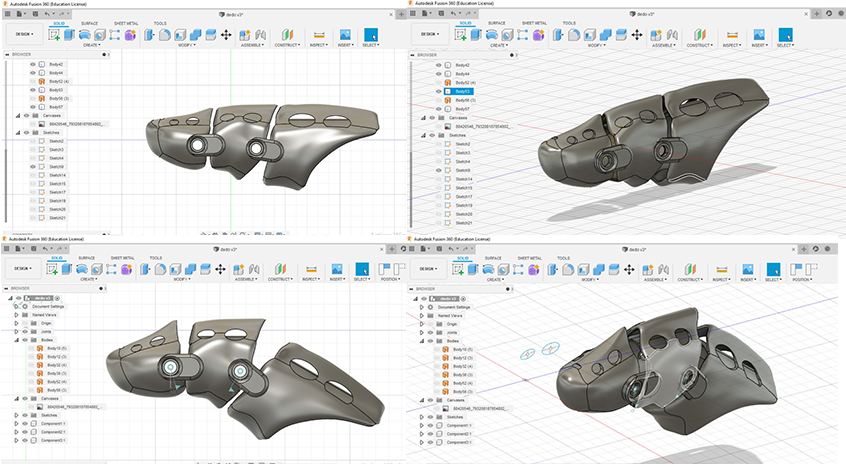Group assignment
Test the design rules for your 3D printer We worked with a classmate from the FabAcademy in his place called Maker Group Ecuador and here you go the link of his web page
LINK
3D Printing
A 3D printer is a computer-aided manufacturing (CAM) device that creates three-dimensional objects. Like a traditional printer, a 3D printer receives digital data from a computer as input. However, instead of printing the output on paper, a 3D printer builds a three-dimensional model out of a custom material. 3D printers use a process called additive manufacturing to form (or "print") physical objects layer by layer until the model is complete. This is different than subtractive manufacturing, in which a machine reshapes or removes material from an existing mold. Since 3D printers create models from scratch, they are more efficient and produce less waste than subtractive manufacturing devices. The process of printing a 3D model varies depending on the material used to create the object. For example, when building a plastic model, a 3D printer may heat and fuse the layers of plastic together using a process called fused deposition modeling (FDM). When creating a metallic object, a 3D printer may use a process called direct metal laser sintering (DMLS). This method forms thins layers of metal from metallic powder using a high powered laser. While 3D printing has been possible since the 1980s, it has been primarily used for large scale industrial purposes. However, in recent years, 3D printers have become much cheaper and are now available to the consumer market. As the technology becomes more widespread, 3D printers may become a viable means for people to create their own home products and replacement parts.
LINK3D Scanning
3D Laser Scanning is a non-contact, non-destructive technology that digitally captures the shape of physical objects using a line of laser light. 3D laser scanners create “point clouds” of data from the surface of an object. In other words, 3D laser scanning is a way to capture a physical object’s exact size and shape into the computer world as a digital 3-dimensional representation. 3D laser scanners measure fine details and capture free-form shapes to quickly generate highly accurate point clouds. 3D laser scanning is ideally suited to the measurement and inspection of contoured surfaces and complex geometries which require massive amounts of data for their accurate description and where doing this is impractical with the use of traditional measurement methods or a touch probe.
LINK
We worked with this device 3D Systems iSense for iPad/iPhone 3D Scanner.

Hands scanned in different positions to study them for the final project


Preparing the 3D printer in the Lab.

Individual assignment:
- Design and 3D print an object (small, few cm3, limited by printer time) that could not be made subtractively - 3D scan an object (and optionally print it)

Basically I used Fusion 360 to make this design. I decided to work with one finger of my final project to take advantaje of the understanding of this piece. It's impossible to make with substractively technology because of the geometry of the design. First of all, you have to understand the way a 3D printer works and its limitations.

Preparing the Final Project
Some extra hands to understand the movement.

Extra 3D modeling INVENTOR Autodesk
I´m presenting the process of 3d modeling for a case to protect my programmer

First make a sketch to define the volumes of the PCB of my programmer, based on these dimensions the appropriate design of the case will be made.

Once the initial sizes were defined I proceeded to draw the upper part, that is, the cap. The tools used are very simple, basically the steps that were followed were to draw, respecting the measurements and then extrude to generate volumes.

In the same way, in reference to the dimensions established in the cap, the complete body was modeled, in the same way, from a sketch and extrusions.

The best way to check everything is through an assembly, prior to preparing for 3D printing.

Finally, I used CURA to prepare the file for the respective printing.

Done, perfect fit.
Conclusion
- The use and exploitation of the different types of software that have been presented I have used in recent years, however it is very difficult to master one hundred percent. What is presented is an approach to each of them and how I use them to obtain examples aimed at the manufacture of the final project.
- Based on the experience I have from my profession, the recommendation is to learn specific software and identify all the tools so that in this way you can venture into the use of other programs by searching for similar tools.
- The modeling presented has a basic level in terms of the development of the final project, different programs were explored to find the ease of organic digital modeling. The recommendation is to master both mechanical modeling and organic modeling software.
- Using software that is loaded in a cloud is one of the most appropriate options when working with innovation currently, the best finding I had was Fusion 360.
- I will not share all the files because I am using some of them for my academic research.
Files
- Exoglove STL
- Hand STL
Case Files